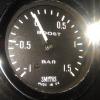
Wiring In Master Battery Cut Off With Resistor

Best Answer dklawson , 09 March 2014 - 04:52 PM
The first diagram you posted was for the FIA sanctioned switch design. To paraphrase what is on the leaflet, there are three sets of contacts. Two are normally open and one is normally closed (when the switch is in the OFF position).
As discussed above, you install the switch in the main battery cable using the threaded terminals. When the switch is turned to the ON position, current to/from the battery passes through the switch. Parallel to that contact is a contact installed in the wire going to coil (+). Thus, when you turn the key to the OFF position, the connection to both the battery AND the coil are broken at the same time. Those are the two contacts that are normally open in the OFF position and closed when the switch is in the ON position.
The remaining contact is closed when the switch is in the OFF position. It is the one the resistor is connected to. The easiest way to wire it is to run a short jumper wire between the threaded switch terminal that is NOT connected to the battery and one of the small normally closed switch terminals. The other normally closed switch terminal receives a connection to the resistor and finally the other side of the resistor is connected to earth. What this does is provide a path to earth for the alternator output when the switch is turned to the OFF position. The idea is that you will reduce or eliminate the voltage spike that occurs when you disconnect a running alternator from its load (battery). Without the resistor you stand a good chance of damaging the alternator.
Go to the full post
#1

Posted 09 March 2014 - 02:53 PM
[attachment=156405:20140309_144825.jpg]
#2

Posted 09 March 2014 - 03:23 PM
The aim will be to provide an alternative earth to the distributor for the coil. It's breaking the earth that causes the spark, so a permanent earth means no break & no spark. It will serve as an immobiliser but it's also important for stopping the engine, which would still run off the alternator if you had to use the battery cut off in anger. It's an entirely separate circuit.
Edit: actually I think you'll need to look at the switch to confirm what extra terminals there are & when they're live. The resistor should connect when the battery isn't to provide a ballast to stop the alternator doing itself damage. I can't really tell about the ignition, it could be used as above or it could be a simple break in the supply side.
#3

Posted 09 March 2014 - 04:10 PM
[attachment=156409:FIAkill.jpeg]
#4

Posted 09 March 2014 - 04:25 PM
Makes sense, Just confirm your switch has the ignition circuit "made" when the battery is connected and the other pair of terminals are open/closed the other way round.
#5

Posted 09 March 2014 - 04:26 PM
the best way and only way to wire in a master switch is to run it ONLY on the battery live feed cable, as close to the battery as possible. one end from battery to cutt off switch and the other to the solenoid as per normal. any other place and even if you turn it off you still have live wires, which can be used to start the car or cause a fire if the cars upsidown in the wall...
:) thats what we do on all race cars anyway
#6

Posted 09 March 2014 - 04:34 PM
the best way and only way to wire in a master switch is to run it ONLY on the battery live feed cable, as close to the battery as possible. one end from battery to cutt off switch and the other to the solenoid as per normal. any other place and even if you turn it off you still have live wires, which can be used to start the car or cause a fire if the cars upsidown in the wall...
:) thats what we do on all race cars anyway
Thats how it is at the moment, but turning the switch off wouldn't kill the engine.
#7

Posted 09 March 2014 - 04:52 PM Best Answer
The first diagram you posted was for the FIA sanctioned switch design. To paraphrase what is on the leaflet, there are three sets of contacts. Two are normally open and one is normally closed (when the switch is in the OFF position).
As discussed above, you install the switch in the main battery cable using the threaded terminals. When the switch is turned to the ON position, current to/from the battery passes through the switch. Parallel to that contact is a contact installed in the wire going to coil (+). Thus, when you turn the key to the OFF position, the connection to both the battery AND the coil are broken at the same time. Those are the two contacts that are normally open in the OFF position and closed when the switch is in the ON position.
The remaining contact is closed when the switch is in the OFF position. It is the one the resistor is connected to. The easiest way to wire it is to run a short jumper wire between the threaded switch terminal that is NOT connected to the battery and one of the small normally closed switch terminals. The other normally closed switch terminal receives a connection to the resistor and finally the other side of the resistor is connected to earth. What this does is provide a path to earth for the alternator output when the switch is turned to the OFF position. The idea is that you will reduce or eliminate the voltage spike that occurs when you disconnect a running alternator from its load (battery). Without the resistor you stand a good chance of damaging the alternator.
Edited by dklawson, 09 March 2014 - 04:53 PM.
#8

Posted 09 March 2014 - 06:06 PM
Yes, that is the idea of the resistor, however it will not work, because if it has a low enough value to protect the alternator, it will also allow far too much current through when the switch is off. It should be a diode, anode to the car,s electrical system, cathode to the battery +ve, so it is blocking completely as regards power from the battery when the switch is off, and yet will pass full alternator output, less a drop of a volt or so, into the battery if the engine is running. The diode needs to be rated, with a heatsink if necessary, for full alternator current output, for as long as it takes the second set of contacts on the switch to shut down the engine.
It is amazing how an incorrect and useless technique such as using a resistor can become established practice, when the correct implementation is just as simple. There are also switches with a fuse, which is supposed to keep the radio, and anything else with a memory, powered up when the switch is off, and will blow if some scumbag tries to steal the car. Again, not the best technique, as a solid state current limiter would be less of a nuisance, but at least it does work, sort of, for its intended purpose.
#9

Posted 09 March 2014 - 06:21 PM
The first diagram you posted was for the FIA sanctioned switch design. To paraphrase what is on the leaflet, there are three sets of contacts. Two are normally open and one is normally closed (when the switch is in the OFF position).
As discussed above, you install the switch in the main battery cable using the threaded terminals. When the switch is turned to the ON position, current to/from the battery passes through the switch. Parallel to that contact is a contact installed in the wire going to coil (+). Thus, when you turn the key to the OFF position, the connection to both the battery AND the coil are broken at the same time. Those are the two contacts that are normally open in the OFF position and closed when the switch is in the ON position.
The remaining contact is closed when the switch is in the OFF position. It is the one the resistor is connected to. The easiest way to wire it is to run a short jumper wire between the threaded switch terminal that is NOT connected to the battery and one of the small normally closed switch terminals. The other normally closed switch terminal receives a connection to the resistor and finally the other side of the resistor is connected to earth. What this does is provide a path to earth for the alternator output when the switch is turned to the OFF position. The idea is that you will reduce or eliminate the voltage spike that occurs when you disconnect a running alternator from its load (battery). Without the resistor you stand a good chance of damaging the alternator.
The on, off switch terminals like this?
[attachment=156413:31R7C45z4AL.jpeg]
#10

Posted 09 March 2014 - 06:32 PM
The diode goes across the two large main terminals, the others being wired to shut down the engine as laready advised.
#11

Posted 09 March 2014 - 09:59 PM
Tiger I know we have discussed this before and while I don't disagree with your comments about the diode, this an FIA certified switch design which is typically supplied with a resistor, the design does work and I would say resistor failure is very, very uncommon.
You said "... resistor, however it will not work, because if it has a low enough value to protect the alternator, it will also allow far too much current through when the switch is off".
I assume your point is "too much current" would cause the resistor to overheat and burn out. The current pulse is short lived and while it probably does tax the resistor it is not common for them to burn out. They are typically wire wound devices packaged in ceramic. While any electronic component can fail, I have never seen a failed kill switch resistor.
You do not have to take my word for this. All that is necessary is to go to the tech inspections before a race and watch as car after car goes through the process of having its kill switch tested by the inspectors. The cars all have a version of this switch with this wiring. The engines stop and neither the resistors nor the alternators burn out.
It has been over a year since I installed one of these switches and I do not have a resistor to measure. However, I did find that Demon Tweeks and other resellers offer replacement resistors. They are surprisingly low-Wattage but the resistance is higher than you probably anticipated. (See the picture image below of a typical kill switch resistor from eBay auction 181095396029).
Hubba-Hubba, yes, those switch terminals. What they are showing in the picture is which pairs of contacts will be "OFF" together and which will be "ON" together. A-B and 2-2 will be for the battery cable and ignition coil power circuits respectively. 1-1 will be for the alternator resistor.
#12

Posted 09 March 2014 - 10:12 PM
1 user(s) are reading this topic
0 members, 1 guests, 0 anonymous users














